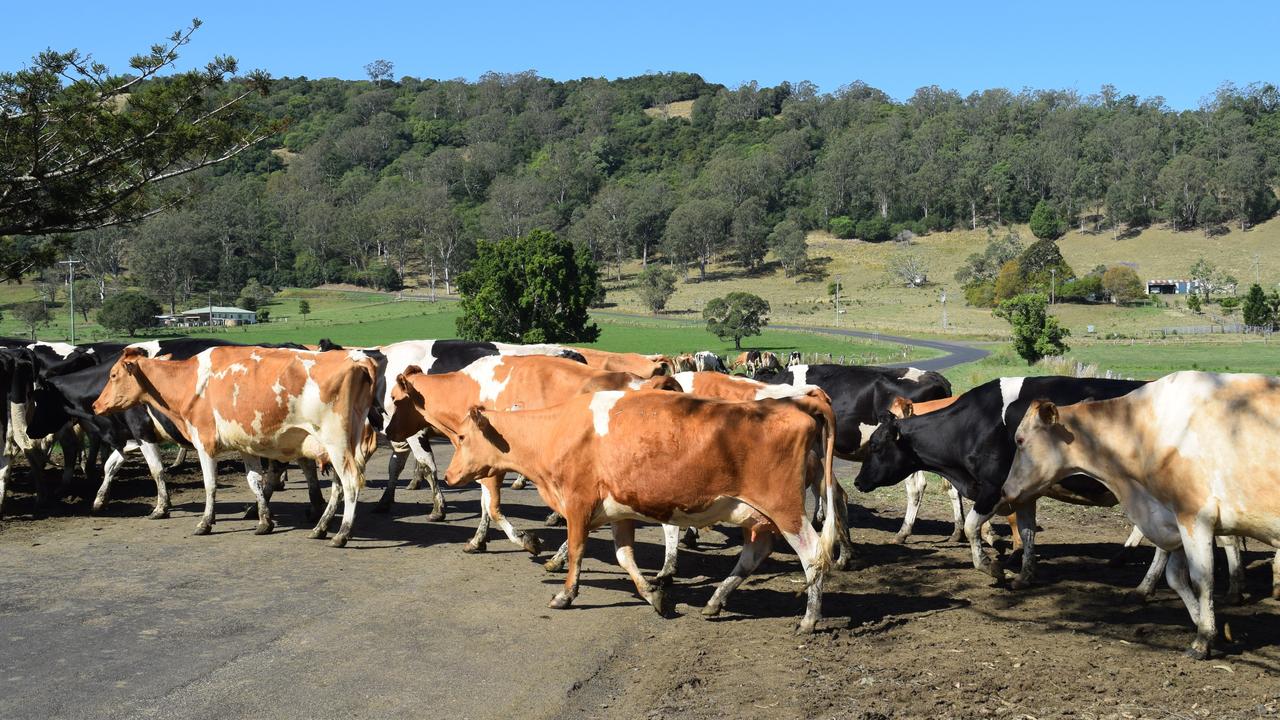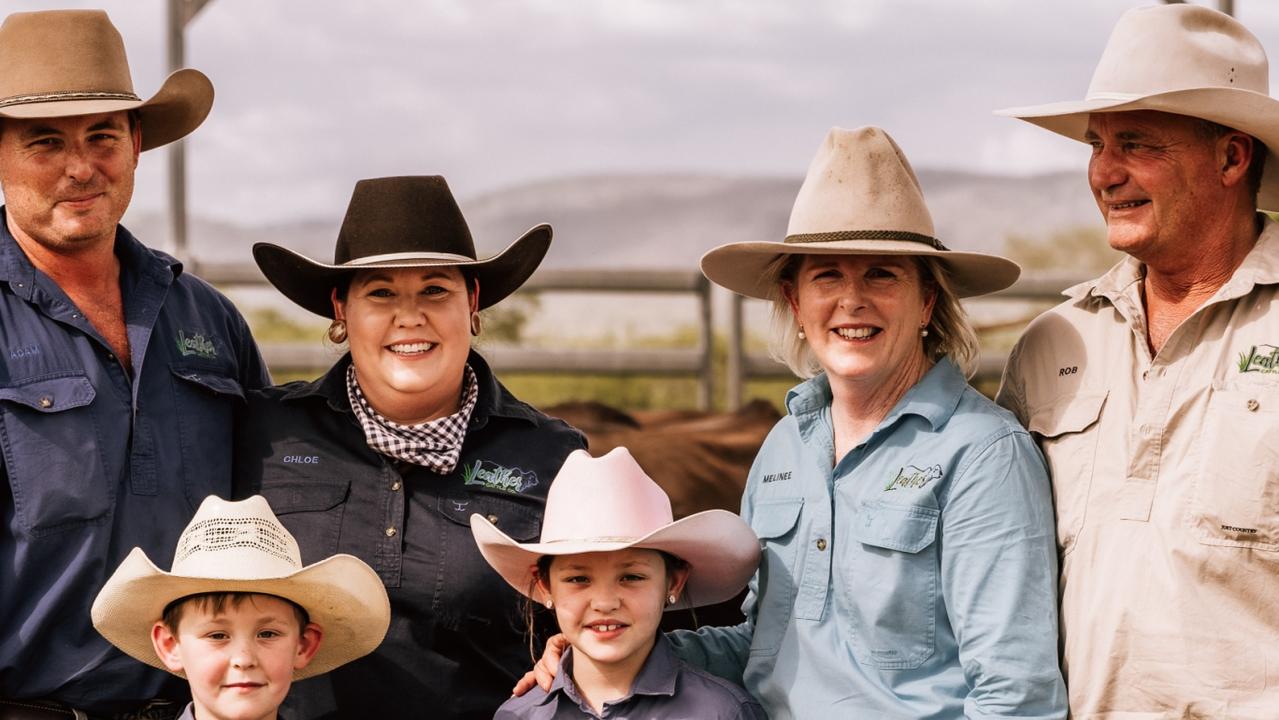‘I am not scared by carbon policy’: Female farmers set dairy agenda
Three dairy women reveal how they are farming for a sustainable future, and why the industry should pay attention to their priorities.
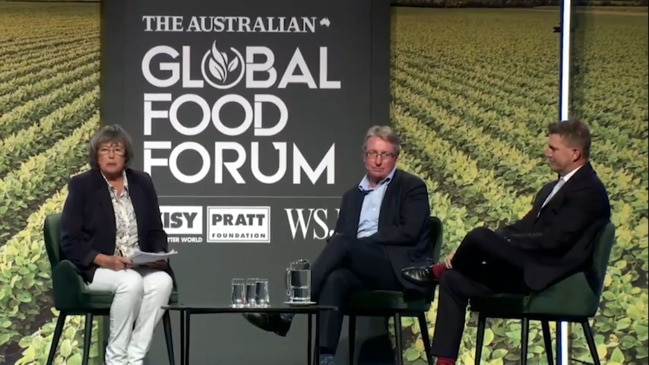
Dairy farmers Lauren Finger, Renata Cumming and Kate Mirams all see a bright future in dairy.
All three women are working hard to improve outcomes for the land and livestock they manage, and the people upon which the industry relies.
Here, the progressive female farmers reveal what they love about the sector, and what they are doing to make it better.

LAUREN FINGER, YANNATHAN, WEST GIPPSLAND
West Gippsland dairy farmer Lauren Finger is a member of the Australian Dairy Plan’s Joint Transition Team who “always wanted to be a farmer”.
“Growing up in the city, I took every opportunity to work with Uncle Robert on the family farm near Glenrowan, in North East Victoria, breeding and showing beef cattle, chasing the header, carting small square bales of hay,” Lauren said.
“I loved the country and its people, the open space and the feeling of having something to show for a day’s work.
“I met my first dairy cows as a vet student, and was amazed at how civilised they were compared to the beef cattle I was used to. I met my husband not that long after as a new graduate vet, and thought he was pretty civilised too.
“We started our business together on a share-farm in 2007. Grass hay was $100 a roll, if you could get it. For a few months, we wondered what we’d done. Since then, we’ve ridden some pretty big waves of milk prices, input prices and cattle prices. The fact that no two years are ever the same is part of what keeps farming interesting for us, if not always easy.

“We purchased our own farm in 2017, and have been fortunate that three years of good milk prices have allowed us to make some much-needed improvements, including a new dairy, which is nearly complete. Why then, do I feel so exhausted?
“If last year was the Great Resignation, I think this year is the Great Exhaustion. Whether you’re in the city or country, employee, employer or unemployed, kids or no kids, we’ve all now had more than two years of constant stress and uncertainty. From imposed rules and lockdowns, we’ve now got illness, workforce shortages, war, supply chain issues and the value of a dollar to worry about. And these things aren’t going away in a hurry.
“’Choose your hard’ is a catchphrase that’s stuck in my mind lately. Most of the worthwhile things in life aren’t easy, and choosing the easy option often gets you to a place that’s hard anyway.
“Dairy farming is hard. I choose to be a dairy farmer. I get to be my own boss, have variety in my work, and see something tangible for it. Our hard work has been rewarded with wealth that supports our family to have choices in life. We chose to build a new dairy.
“What of the outlook for the dairy industry from here? One of the outcomes of being part of the Joint Transition Team is that I naturally use the word “we” when talking about the dairy industry. “We” is the farmers, the processors, Dairy Australia, our advocacy bodies, our service providers and our employees.
“We need to work together to ensure long-term prosperity across the supply chain. We need to speak positively of our industry and the opportunity it offers. We need to share with our consumers the nutritional value of our products, created by nature in all its wonder.
“I am not scared of milk alternatives or fake meat. I am not scared by carbon policy. In time, I hope our scientists and politicians will recognise that grazing ruminants coexisted with humans long before we started the industrial revolution that warmed the planet. Grazing ruminants are nature’s design to allow capture of solar energy via plants to a form of energy that humans can use for survival.
“I see a bright future for my farm. There’s so much learning still to do, challenges to keep us interested, children to inspire with the greatest purpose I can think of — producing the beautiful, natural food that is essential to us all.”
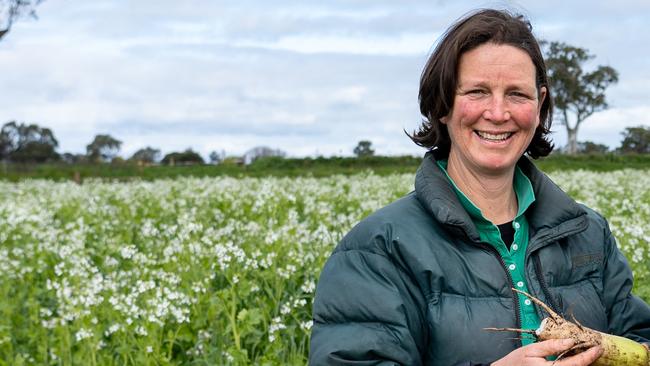
KATE MIRAMS, NEWRY, GIPPSLAND
Newry dairy farmer Kate Mirams is increasing the productive potential of her land using insights into soil health, and new grazing practices and pasture species to improve microbial populations of her soil.
“Initially, our grazing management focused on production of high quality feed for cows, without insight into what was happening in the soil,” said Kate, who milks 300 spring-calving cows on 130ha in Gippsland.
Kate believes there’s better bang for her buck in having better soil health compared to anything else.
“If I can farm in a way that increases soil organic carbon across my farm by 3 to 5 per cent, my soil water-holding capacity would go up as much as half a megalitre, and microbes would greatly increase plant access to nutrients that are currently locked in the soil,” she said.
Maintaining soil temperature by keeping the soil surface shaded and covered at all the times of the year was crucial, Kate said.
“On hot days, bare soil could heat up to 60C, while covered soil might be in the 20Cs. That difference will greatly increase evaporation but will kill the soil microbes,” she said.
Kate said having green living plants growing every day of the year ensured there was a food source for microbes year-round.
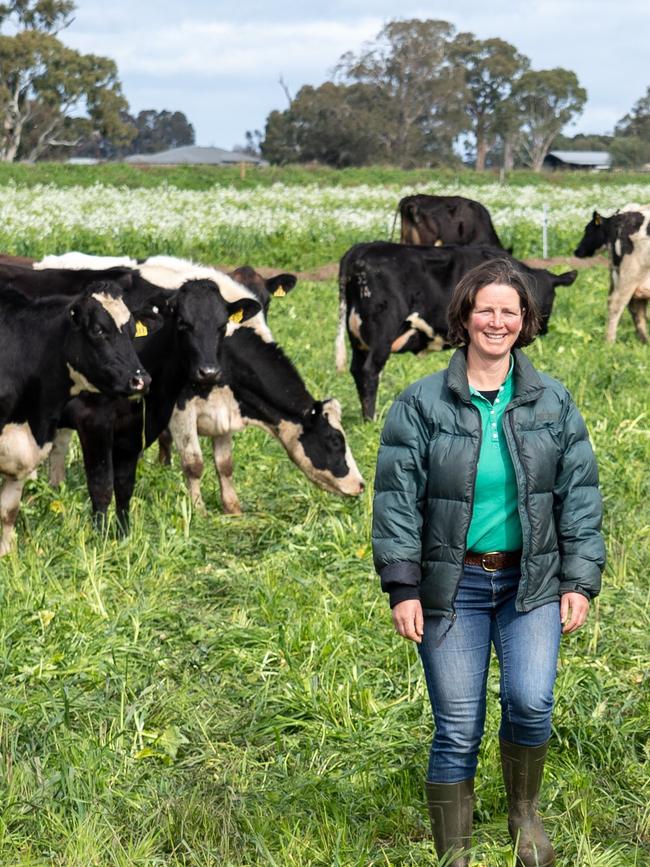
“Root exudates produce food for microbes in the soil. If we have nothing growing, then the microbes die off,” she said. “I’ve come from a culture of high utilisation. Now I know that some pasture needs to be smashed back into the soil as food for microbes.”
Plant diversity was key to improving soil life, she said. Different species offer varying root structures and depths, which provided different types of food for microbes and broke up the soil.
“After two years of summer-winter multi-species cropping we realised there’s a boom and bust cycle — you’ve terminated the old crop, so there’s a shock to the microbes until the new crop establishes.
“It’s also expensive to double crop,” Kate says.
Kate has moved to multi-species perennial pastures including lucerne, chicory, grasses, plantain and several clovers, with short grazing periods and long recovery periods.
“Even though the pasture looks too long for rye-grass, the other species are at their highest energy content, meaning the average feed value is fine for cows,” she said. “It’s really good learning through spring. If you haven’t got completely dominant rye-grass pasture, you don’t have the crash when it goes to seed.”
Kate likens her soil to a cow’s rumen.
“We need to keep the microbial population steady,” she said.
“We don’t do things to shock the rumen like turn feed on or off, we’re careful to keep homeostasis, a constant pH, because we know how important it is to keep the microbial population happy. The microbes that have the best long-term storage of carbon, and created the greatest increase in soil water and nutrient-holding capacity are fungi.
“But most dairy soils are bacterial dominant. We need to learn how to create the right conditions for a soil to become fungal dominant.
“I’m learning how to change to fungal dominant soil and the things we know about achieving that are zero till; total ground cover, green growing plants all year, long plant recovery periods, short sharp grazing periods.”
Kate believes farming is “more interesting and exciting when you’re at the forefront of knowledge”.
“Instead of feeling despair about the climate emergency, I’m doing what I can to sequester carbon, stop nutrients going into waterways and take good care of the land.
“I’m also learning techniques that help me be more resilient in a variable climate, share with other farmers what I’ve learnt, to help improve the resilience of agriculture as a whole.”

RENATA CUMMING, SCOTTS CREEK
When Renata Cumming was nominated for the Young Dairy Leader Award at the Great South West Dairy Awards earlier this year, she felt hesitant to apply at first but later went on to win.
Rather than let her inhibitions dominate, she used them to drive her forward in the hope of inspiring other women who might be holding back in the industry.
“A part of me thought, I don’t do that much, I don’t know why I’ve been nominated but I made the decision to apply because I felt it was really important to have young women represented in the dairy industry,” Renata said.
“I felt that if another young woman saw my story and felt inspired or empowered or a little bit more encouraged to do something important to her in the ag industry then that would be worth it.”
Renata’s passion for dairy and the broader agricultural industry is clear as she talks about her hopes for the future of the sector, developing pathways for young people to enter the industry and creating support networks for women in dairy to have a voice.
Renata, who helps her partner Matt Grant run a 430-cow herd at Scotts Creek, between Timboon and Port Campbell, was instrumental in helping develop an interactive conference called Cream of the Crop for women in the southwest dairy region earlier this year.
The event was the brainchild of Renata and two other ag industry women, Lucy Collins and Chloe Brown, who recognised the need for a forum to give women in dairy the chance to come together for connection, personal development, education and motivation.
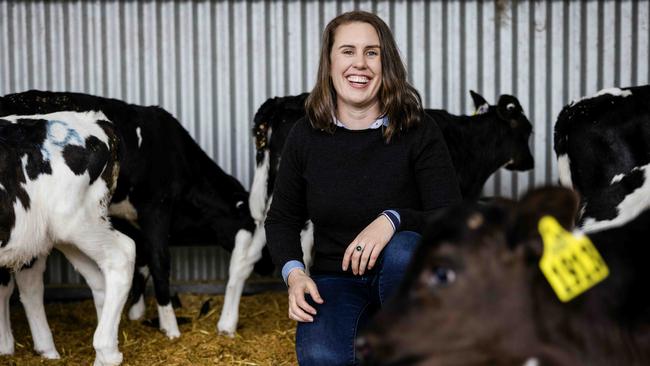
“It is so important to nurture and support women in dairy.
“It is important to create those safe spaces for people to come together and learn,” Renata said, adding the event was so well received it would now be held every year.
Promoting the dairy industry to young people as a career choice is also a passion for Renata.
“There are so many challenges facing the dairy industry that we often don’t celebrate all the good things about it, like becoming more sustainable from an environmental perspective but also financial and animal welfare, tree planting, better management of fertiliser and dealing with effluent in more appropriate ways, trials around pasture management and carbon sequestration, ” Renata said.
“There is lots going on and there are opportunities to be involved in and I hope we continue to do all this trial work, invest in the future and find better ways to communicate what we do with consumers.
“Often the loudest voices aren’t involved with the dairy industry at all, which is not helpful.
“We need to speak about the good things we are doing because that both helps consumers understand how our food is produced and it paints a better picture for young people who are considering entering the industry.”
Renata is also involved with the Primary Industries Education Foundation Australia Vic Farmer Time program where she joins a video call with school students to talk about dairying and farm life.
“The Grade 1 and 2 kids ask some interesting questions from what do you do with sick cows through to why do cows have spots?” Renata said.
“It’s important work.
“How can we expect consumers to make good decisions about food when they don’t even know where it comes from?
“It starts with little kids.”



